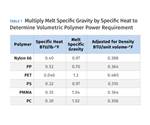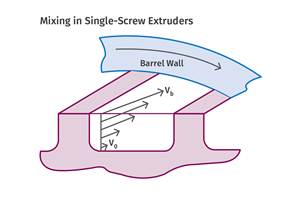Extrusion: The Challenges of Extruding Highly Filled Polymers
These materials require screw changes and modifications in upstream and downstream equipment and operating procedures.
Processors have been extruding filled polymers for many years. Historically, the percentage of filler has usually been less than 30% by weight—or only 10-15% by volume—because the fillers have a specific gravity 3-10 times that of the polymer. More recently, I have worked with some new compounds containing as much as 85% filler by weight, which results in more filler than polymer by volume. These mixtures usually do not run well on traditional screw designs.
Remember the basic principle of solids feeding: In order for the polymer particles to flow forward, the material must have less frictional drag on the screw than on the barrel. The screw surface area is usually substantially greater than the barrel area in the feed section; that ratio is referred to as the aspect ratio. To offset the effect of the aspect ratio, the drag necessary to move the polymer particles forward is typically created by heating the barrel or by altering the barrel surface finish for greater drag.
However, many of the typical fillers are angular or irregular in particle shape, and quite abrasive, making it difficult to increase the frictional drag at the barrel wall enough to offset the drag on the screw surface when the aspect ratio may be 1.25:1 to 1.35:1. Adding heat to the barrel wall can make matters worse by melting some polymer near the barrel wall and decreasing the barrel drag in relation to the screw drag. In some cases it might be necessary to essentially reverse the normal solids-feeding process to reduce the frictional drag against the screw surface by techniques such as preheating the polymer, or by using heated screws, coatings, or processing aids.
Know How Extrusion—Get more insights on Extrusion from our expert authors.
Compression or compression ratio in conventional polymer screws is necessary because of the generally low feeding efficiency of polymer pellets and the effects of melt formation and melt removal, allowing the melt to flow faster than the solid. Conversely, some filler-particle geometries improve solids-feeding efficiency because they do not slip over one another. This results in less compression being needed to achieve the required feed rate. Since the fillers do not melt, they do not flow, and the flow properties of the mixture become a combination of solid particle properties and normal melt flow. As a result, screws with compression sections normally used for neat polymers may simply plug the channel with filler as the volume reduces along the screw length because of the lack of flow of the filler.
Also, as compression proceeds, the relatively small amount of polymer in the filled compound can be squeezed out, leaving nothing but tightly compacted filler. Since a screw is essentially a spiral wedge, even with no compression the filler can become so tightly compacted that it can stall the drive or even break the screw. As a result, screws with zero or even negative compression have often been found effective.
Once feeding has been established, melting becomes easier in some ways and more difficult in others. Without normal channel compression, the conventional melting mechanism is greatly compromised, and melting becomes based more on conductive heating than on shear heating. Screw designs that basically roll or break the polymer bed up in the screw channel to expose more surface area are often more effective than even barrier designs or high-shear mixers.
Since most fillers have a lower specific heat than polymers, the amount of energy required to raise a pound of the mixture to the processing temperature is greatly reduced. Moreover, most fillers have a higher thermal conductivity than polymers, aiding in conductive heating and melting.
There are few general rules to follow on screw designs to process high filler loadings.
Once melting is completed, shear heating then becomes more problematic, as high loadings of fillers in almost all cases greatly increase the viscosity and reduce shear thinning, so section lengths after completion of melting should be reduced. Upstream and downstream changes are for another discussion. Fillers affect entry into the screw due to bridging/compaction and cause increased pressure drop through the tooling from the higher- viscosity polymer. Pressure development in the screw also is less predictable and more variable because of the discontinuity in the melt caused by the filler and its scouring of the barrel wall.
Unfortunately, there are few general rules to follow for screw designs to process high filler loadings. So much depends on the characteristics of the filler particles, the percentages of the components of the mixtures, the viscosity of the melted polymer, the melting rate of the mixture, and the temperature of the screw and barrel. Just be aware that very high filler loadings will require some changes in the screw, upstream and downstream equipment, and operating procedures. Don’t be surprised if it takes a few iterations.
ABOUT THE AUTHOR: Jim Frankland is a mechanical engineer who has been involved in all types of extrusion processing for more than 40 years. He is now president of Frankland Plastics Consulting, LLC. Contact jim.frankland@comcast.net or (724)651-9196.
Related Content
How Much L/D Do You Really Need?
Just like selecting the extruder size and drive combination, the L/D should be carefully evaluated.
Read MoreSingle vs. Twin-Screw Extruders: Why Mixing is Different
There have been many attempts to provide twin-screw-like mixing in singles, but except at very limited outputs none have been adequate. The odds of future success are long due to the inherent differences in the equipment types.
Read MoreHow Polymer Melts in Single-Screw Extruders
Understanding how polymer melts in a single-screw extruder could help you optimize your screw design to eliminate defect-causing solid polymer fragments.
Read MoreTroubleshooting Screw and Barrel Wear in Extrusion
Extruder screws and barrels will wear over time. If you are seeing a reduction in specific rate and higher discharge temperatures, wear is the likely culprit.
Read MoreRead Next
Extrusion: The Role of Polymer Density in Screw Design
Density affects the mass flow rate, and energy transfer is based on mass, not volume. As a result, polymer density enters into practically every calculation in a screw design.
Read MoreWhy (and What) You Need to Dry
Other than polyolefins, almost every other polymer exhibits some level of polarity and therefore can absorb a certain amount of moisture from the atmosphere. Here’s a look at some of these materials, and what needs to be done to dry them.
Read MoreTroubleshooting Screw and Barrel Wear in Extrusion
Extruder screws and barrels will wear over time. If you are seeing a reduction in specific rate and higher discharge temperatures, wear is the likely culprit.
Read More.jpg;width=70;height=70;mode=crop)












